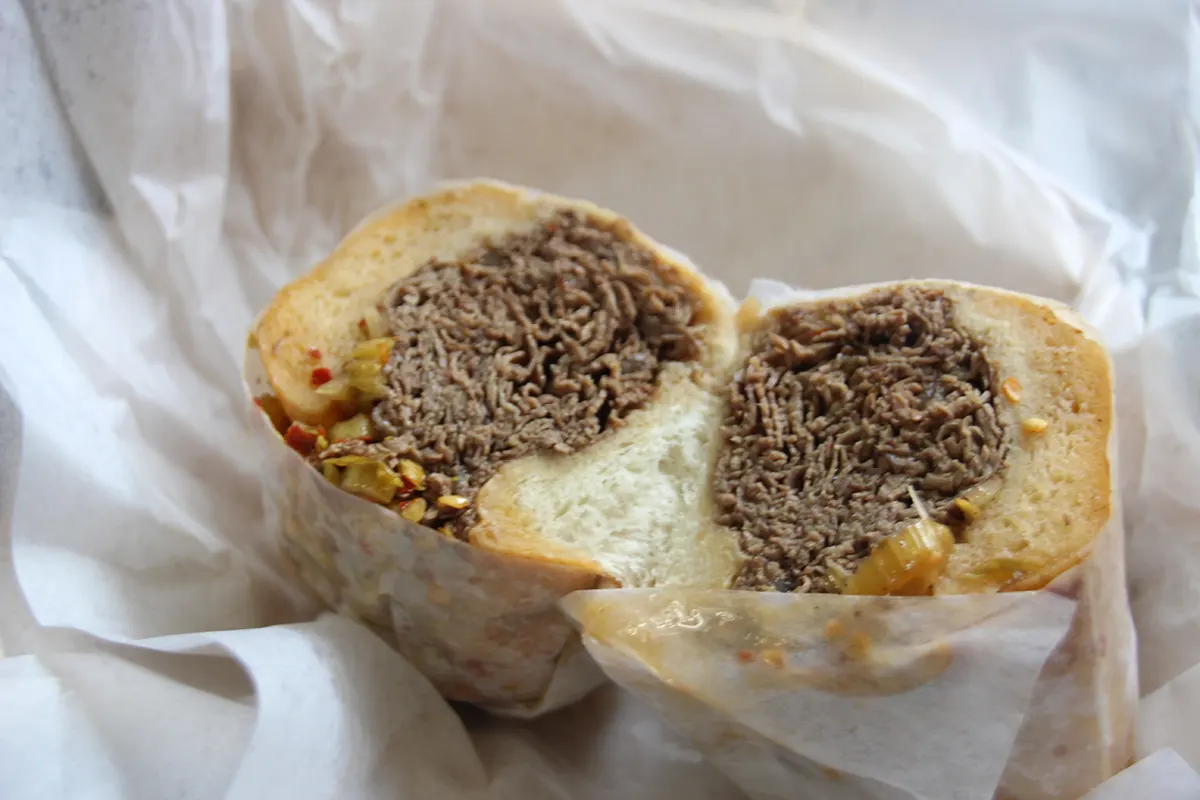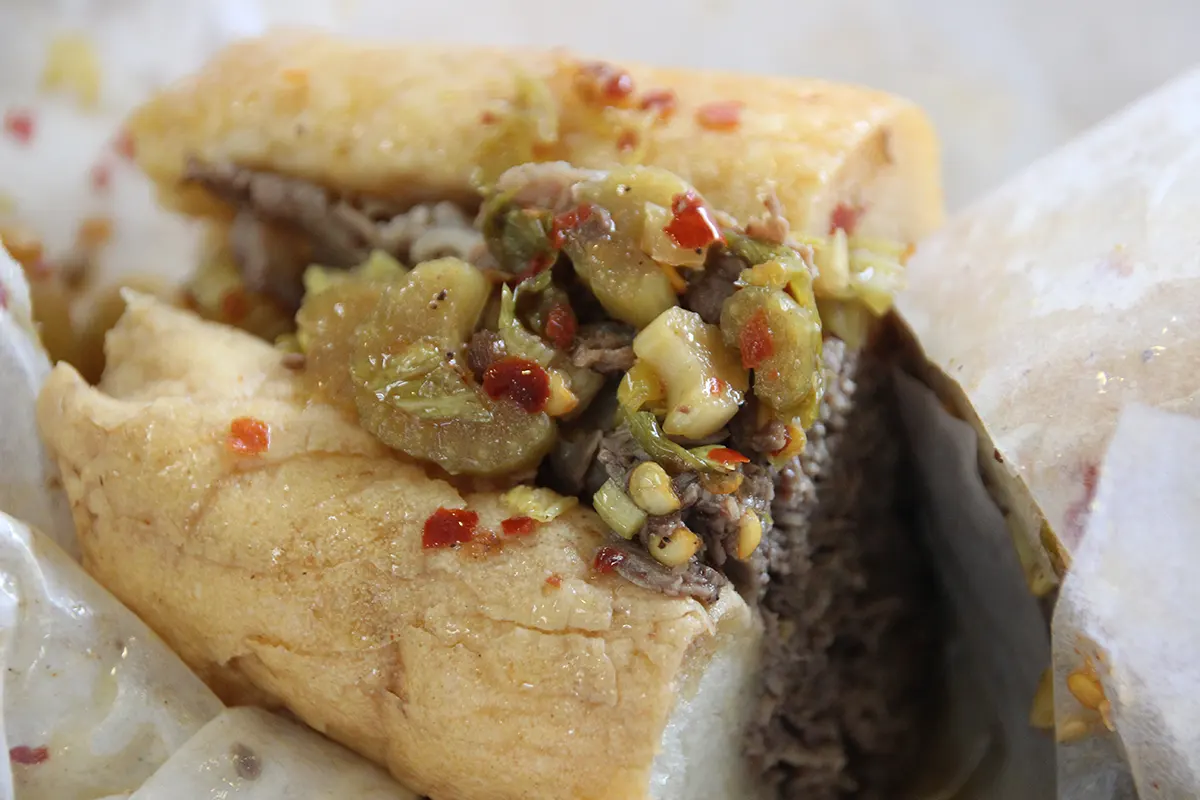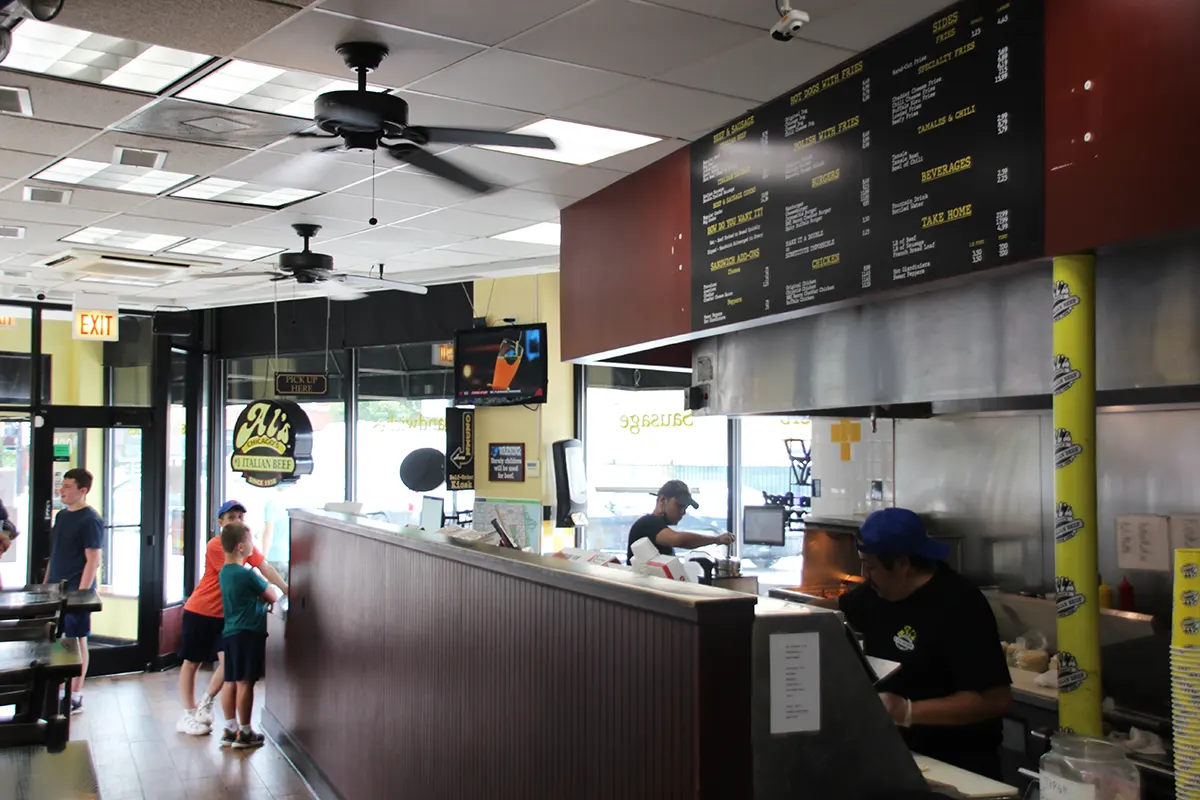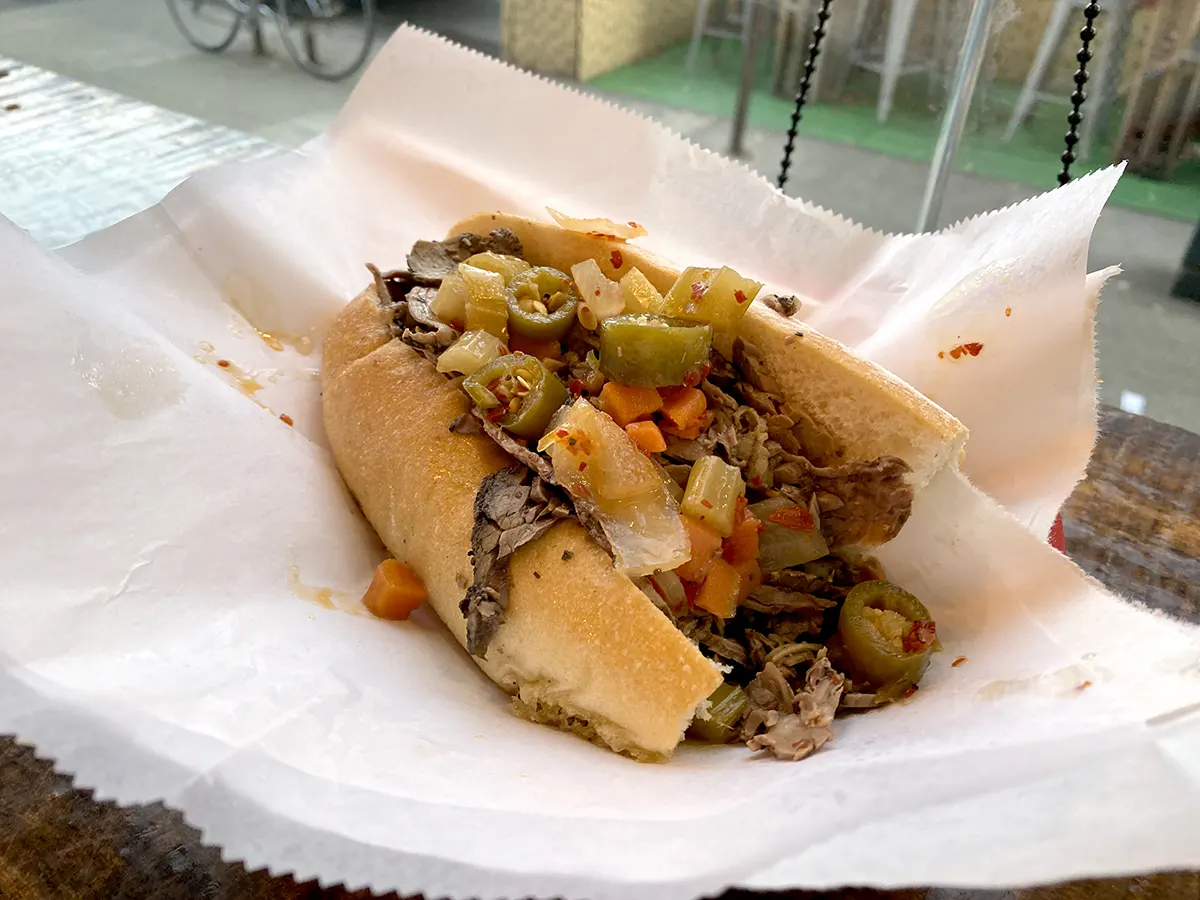The History of Chicago’s Italian Beef Sandwich
By Ian MacAllen on Tuesday, January 30th, 2024 at 6:36 pm | 26,590 views

Chicago’s meatpacking industry helped make beef a staple on American plates, but it also shaped an iconic Italian sandwich.
Chicago’s location at the intersection of western agriculture and eastern consumer markets made it an ideal place to process cattle into edible beef and packaged it onto railcars to ship to cities. These are the stockyards that served as the setting for the iconic Upton Sinclair novel, The Jungle, outlining the hazardous working conditions and impoverished laborers.
Italian immigrants arriving in Chicago often took jobs in the stockyards, in part because the working conditions were bad. The wages were low, but better than they earned in Italy. And there were other perks of the job like access to discounted meat, off-cuts, and cheaper, less tender pieces of beef. The relationship between Italian laborers and the Chicago stockyards was a big factor in producing the iconic Chicago Italian Beef, a sandwich common throughout the Chicago area but unknown outside the region until just a few years ago.
Today, the ideal Italian Beef is made with a hero roll filled with thinly sliced meat and topped with giardiniera – pickled vegetables that can include hot or sweet peppers. A later development has included topping the sandwich with provolone cheese, but this isn’t a traditional topping. One other feature is the sandwich comes in varying degrees of wetness soaked in the cooking juices, similar to the French Dip developed in California some years before.

The precise origins of the sandwich are somewhat disputed, but the very basic recipes likely come from the domestic kitchens of Italian immigrants. Italians working the stockyards brought home cheap cuts of beef. These tougher cuts of meat could be improved through cooking techniques like braising to help soften the tendons and stringy muscles. These early homecooks developed methods for cooking meat that would eventually fill sandwich breads.
Another contributing factor was wedding parties. Italian immigrant weddings at the time were basic affairs. Known as “peanut weddings,” the receptions featured simple foods. Aside from peanuts that might also be tossed at the happy couple, hosts usually served a selection of sandwiches, but not the elaborate multi-course meals commonly associated with Italian Americans today. These wedding sandwiches eventually evolved into the modern Italian beef.
Anthony Ferreri got his start in the sandwich business after attending a “peanut wedding.” Ferreri came to the conclusion that the thick-sliced sandwich meat would cost less if it was cut thinner. Serving it with some of the cooking juices would bolster the volume and flavor without adding much cost. Since he worked as a truck driver delivering bread, he could produce sandwiches at home and sell them from his truck. He launched a family run business selling sandwiches from his truck.

Ferreri’s son Al worked in the family sandwich business, but also engaged in some low-level criminal activity. Al spent a short period of time in jail, and on his release decided the best course of action would be to open an illegal gambling joint with some of his criminal pals. To cover up the illegal gambling, Al suggested operating a sandwich shop. The shop only had an open charcoal grill at the time, but was nevertheless successful enough Al wanted out of the gambling racket. Al’s sister Frances and her husband Chris Pacelli helped transition the illegal bookie joint into a legitimate food business, and in 1938 opened as Al’s Bar B-Q. Later the shop became Al’s #1 Italian Beef, after Chicago Magazine named it the number one sandwich in 1980. Al’s Italian beef is often credited with creating the sandwich, but that’s not the whole story.
At the same time the Ferreri family was getting their start selling beef sandwiches, Pasquale Scala was selling sausages and pre-sliced meats from a street cart. He may have worked at Italian weddings as a caterer as well, but ultimately he wanted to run his own meat packing company. In 1925, after years of working in the back of a bakery, the Scala Packing Company opened for business. Like Ferreri, Scala recognized that thinner sliced meat would cost less. Among other products like sausages, he sold thin-sliced beef used on wedding sandwiches and eventually Italian beef sandwiches. His company supplied pre-cooked Italian meats for the rest of the century, closing in the 2000s. It’s not clear though whether he actually invented a version of the Italian beef sandwich, or simply copied an existing sandwich.
During the years before World War II, Italian beef sandwiches remained relatively unknown even in the city of Chicago. Ferreri’s was selling sandwiches, but also foods like sausages and hot dogs. The sandwich hadn’t become the mainstay that it is today. Chicagoans preferred corn beef sandwiches at the time–quite the contrast to a few decades later when the Italian Beef would come to dominate.
One reason behind Chicago’s shift from corned beef to Italian beef may be the arrival of the French Dip. The French Dip was invented in California in the early 20th century – there are competing theories as to exactly who – but by the sandwich had started making its way east by midcentury. The theory here can be attributed to Pat Bruno, the former long-time food critic at the Chicago Sun Times. Bruno has since passed away, but according to Kevin Pang at the Chicago Tribune, Bruno had a story about a mystery cook at a Greek-owned coffee shop around 1948. Supposedly, the mysterious cook, Tony, considered the French Dip to be too bland. He wanted to spice things up with garlic and herbs, and in doing so “invented” the Italian beef’s final form. Customers apparently loved the changes, but the owner of the shop did not and he fired Tony. Tony is then alleged to have opened an Italian beef shop down the street, ushering in the era of the modern Italian beef.
The story of Tony would seem far-fetched except that it aligns with the broader timeline of when Chicagoans began eating the Italian beef. Before the war, there aren’t any newspaper references to the sandwich, according to Nick Kindelsperge at the Chicago Tribune. He looked into the paper’s archives and only found the references to the sandwich beginning in the 1950s. Of all the shops known for selling the sandwiches, only Al’s Italian Beef was founded before the war.
Shops like The Patio (1948), Joe Boston’s (1949), Scatchells (1953), and Johnnie’s Beef (1961) also sold other products like hot dogs, hamburgers, and sausages before becoming known for their Italian beef sandwiches. Eventually as the popularity of the sandwich grew, versions were added to menus of other restaurants.
For most people outside Chicago, the first time they heard of an Italian Beef sandwich was likely surrounding the premiere of award-winning series, The Bear. The show opens with Carmen “Carmy” Berzatto attempting to open his brother’s restaurant for the day–and being short on cash for the beef he needs to cook. He trades vintage denim for the beef he needs– and ends up with a cheap, tough cut. That’s okay, though, since the meat on the sandwich is braised and stewed in its own juices and broth.
The Bear’s restaurant scenes are filmed at Mr. Beef, a sandwich shop in business for nearly fifty years. Mr. Beef is owned today by Chris Zucchero who grew up with Christopher Storer, the co-showerunner for The Bear. Zucchero sells some 800 sandwiches a day now, taking over the shop from his father Joe. Joe Zucchero bought the shop from Carl Bonovolanto and Tony Ozzauto in 1979 although it first opened in 1963.
Italian Beef sandwiches are still hard to find outside of the greater Chicago area, but that is finally beginning to change. Al’s Italian Beef has six locations, but all of those are in Chicago or the suburbs.
Buona, a restaurant chain based in Chicago, has opened shops as far away as Wisconsin and Indiana and sells Italian beef sandwiches alongside burgers and pasta. Buono is run by Carlo Buonovolanto, cousins of Carl Bonovolanto who operated Original Mr. Beef after selling the first Mr. Beef to Zucchero.
Perhaps the largest Italian Beef chain is Portillo’s, with spots in the upper midwest, Florida, Texas, Arizona, and California. Dick Portillo opened his first shop, the Dog House, in 1963. In 1967, he renamed it Portillo’s after revamping the menu. He soon expanded in the Chicago area, and in the 2000s began growing beyond the region to California and Florida. The chain has more than 50 locations and Portillo sold it to Berkshire Partners in 2017.
Locating an Italian Beef in New York City isn’t as easy as you might expect. Hank’s Juicy Beef started off at food festivals, and then in July of 2016 opened in lower Manhattan. The food was based on family recipes from Henry “Hank” Tibensky. Unfortunately, the location did not survive the pandemic of 2020. Hank’s operated a few pop-ups in Cobble Hill out of Sixth Ward, a restaurant that has also since closed. While Hank may not be selling sandwiches, the brand is still selling jarred giardiniera.

A few blocks down from where Hank’s pop-up location, Bobbi’s Italian Beef opened in the fall of 2022. The shop is an homage to Chicago dining with Chicago-style hot dogs and craft beers, as well as as Italian Beef sandwiches. According to EaterJason Lux, who owns the shop, previously worked at the Brooklyn Crab in Red Hook, but is originally from Illinois. At the moment, Bobbi’s appears to be the only restaurant offering the iconic Chicago sandwich in New York.
Italian beef is finally expanding beyond the confines of Chicagoland bringing a delicious Italian American dish nationwide. Hopefully, the popularity of The Bear will ensure the continued success of the sandwich and keep it from disappearing into history.
Below is a quick roundup of the Chicago-area shops that specialize in Italian beef sandwiches:
Al’s #1 Italian Beef
1938
1079 W. Taylor Street
The “original” Italian beef shop, opened at first as a cover business for a gambling racket. Al Ferreri then opened it as Al’s Bar B-Q with his sister Frances and her husband Chris Pacelli Sr. In 1980 it was renamed Al’s #1 Italian Beef after winning the title from Chicago Magazine. It’s currently operated by Chris Pacelli, Jr., and has several locations in Chicago and the surrounding suburbs.
The Patio
1948
(closed)
Taylor Street, Chicago
Siblings Don Caputo and Eleanor Varelli operated this hot dog stand and pizzeria. The shop also sold Italian Beef sandwiches.
Joe Boston’s
1949
(closed)
2932 W. Chicago Ave, Humboldt Park
Founded by Joe Boston, the shop closed in 2017. It started out originally as a social club, but was known for house-made meat and giardiniera. It also served Polish sausages.
Scatchell’s
1953
4700 W Cermak Rd, Cicero
Founded by Eddie and Stubby Schatchell and now run by Frankie Levato and Barry Reggi, who took over in 1985.
Johnnie’s Beef
1961
7500, W North Ave, Elmwood Park, IL
Founded by Johnnie Aretos and now owned by his son-in-law Frank Stompanato. The shop makes it’s own beef, giardiniera, and lemon Italian ice. The shop is cash-only.
Portillo’s
1963
(renamed 1967)
Villa Park, IL
Founded by Dick Portillo, the restaurant started out as a hot dog stand, Dog House. He founded it with $1,100 he and his wife intended to use to buy their first home. The business almost failed, in part because Portillo didn’t even know how to properly cook a hot dog. In 1967, it was renamed Portillo’s and offered a menu of fast food like burgers and Italian beef, and began opening additional restaurants around Chicago. Since the 2000s, it has been expanding beyond Chicago, and there are now locations in Florida, Texas, California, Arizona and across the midwest. In 2017, Dick Portillo sold the company to Berkshire Partners.
Odge’s
1972
730 N Damen Ave, Chicago
Only open for lunch, the shop was founded by Edwin Steven “Odge” Boksa Sr and now is run by his son Edwin “Eddie” Jr. The shop is decorated with Route 66 memorabilia and childhood lunch boxes according to Bon Appetite.
Tony’s Italian Beef
1975
7007 S Pulaski Rd, Chicago, IL 60629
A family run shop with their own beef and giardiniera recipe, which includes chickpeas. The shop also offers catering.
Max’s
1979
(Closed)
5754 N Western Ave, Chicago
The shop was founded by Larry and Randee Estes and was known for a bright red giardiniera. The shop closed in 2014, citing rising costs.
Mr. Beef
1979
666 N. Orleans St, Chicago
Joe Zucchero purchased the stand from Carl Bonovolanto and Tony Ozzauto who opened it in 1963. The shop is now run by his son, Chris Zucchero. Mr. Beef also serves as the location for The Bear.
Buona Beef
1980
Berwyn, IL
Founded by Joe and Peggy Buona, the chain is growing chain with locations across the region. Joe was the brother of Carl Buonavolanto, the original Mr. Beef.
Pop’s Italian Beef & Sausage
1980
7153 W 127th Street in Palos Heights, IL
Founded Frank Radochonski with help from his mother Betty.

